Let’s discuss how you can integrate Zoom with WhatsApp and automatically share Zoom recordings with meeting/webinar registrants using WhatsApp Cloud API.
This automation requires a one-time setup, for which we will use Pabbly Connect.
We will first link Zoom with Pabbly Connect to capture the meeting record link, link Pabbly Connect with Zoom to capture registrant data, then link Pabbly Connect with WhatsApp and share the recording link via WhatsApp message.
Steps to Automatically Share Zoom Recording on WhatsApp Via WhatsApp Cloud API
1. Sign In / Sign Up to Pabbly Connect and Create a Workflow
2. Establish a Connection between Zoom and Pabbly Connect
3. Setup Zoom as the Action App to Fetch Meeting Registrants
4. Add an Iterator to the Workflow to Organise Data
5. Add a Filter to the Workflow
6. Setup WhatsApp Cloud API as the Action App to Send Recordings
7. Compose a Message Template
8. Map the Necessary Fields
Step 1:- Sign In / Sign Up to Pabbly Connect and Create a Workflow
A. Sign In / Sign Up
To begin this process, visit Pabbly Connect and create your account by clicking on the ‘Sign Up Free’ button. You can also click on Sign In if you already have an account.
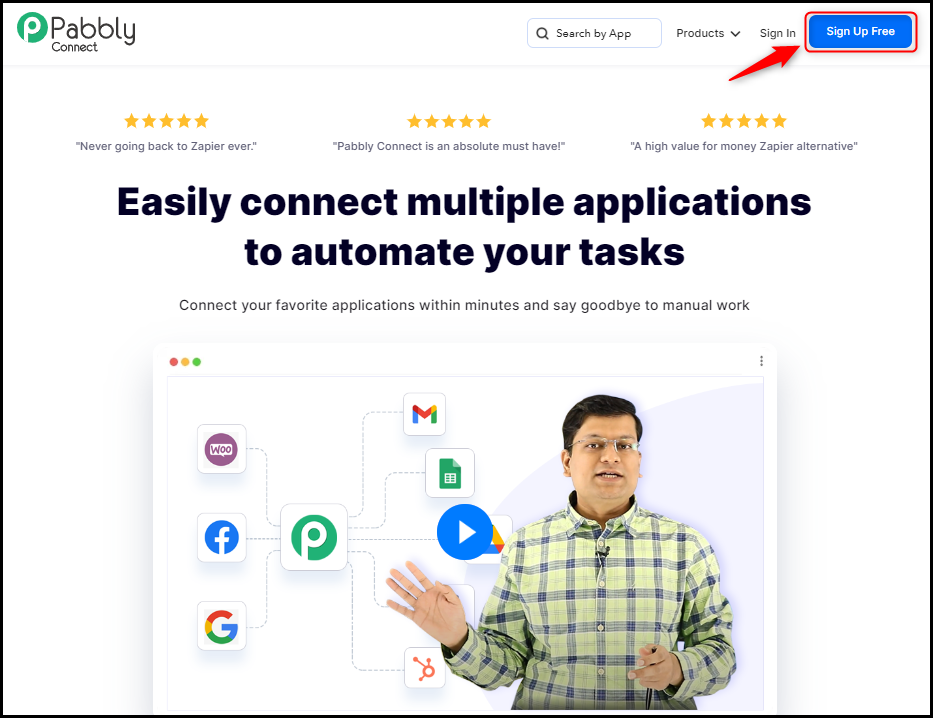
Click on the Pabbly Connect ‘Access Now’ button

B. Create Workflow
To create a new workflow, click the ‘Create Workflow’ button.
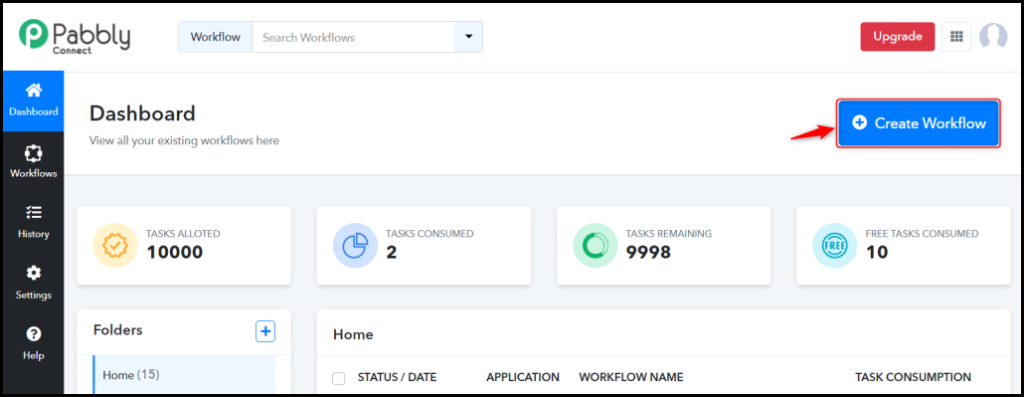
Name your workflow, and click on ‘Create’.

Step 2:- Establish a Connection between Zoom and Pabbly Connect
Trigger allows us to choose the application that will receive the data for Pabbly Connect. In our case, it would be Zoom – This will help us capture the recording link.
A. Trigger App
Choose ‘Zoom’ as the Trigger App, and select ‘Configure Webhooks’ as the Trigger Event.

B. Webhook URL
A new Webhook URL will get generated. You will use this Webhook URL to connect with your Zoom account. Copy the Webhook URL.

As soon as you Copy the Webhook URL, Pabbly Connect will start looking to capture data from Zoom, as indicated by the rotating Waiting For Webhook Response button.

C. Establish Connection
Login to your Zoom account, and click on ‘Advanced’ > ‘App Marketplace’.

You will be redirected to a different page, where you have to expand ‘Develop’ and select ‘Build App’.
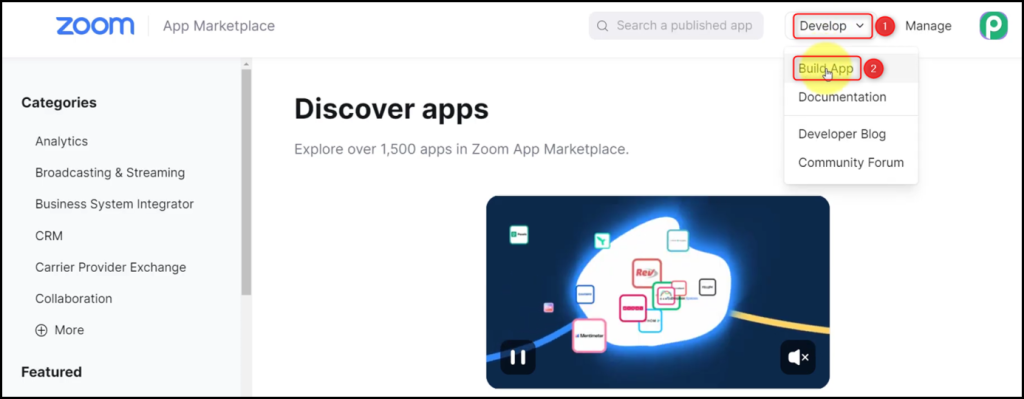
Click the ‘Create’ button under Webhook Only tab, name your Webhook App, and again click on ‘Connect’.

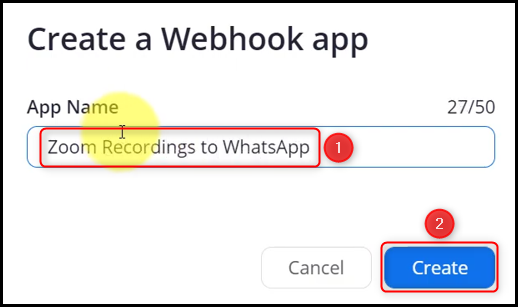
Give a Company Name, Developer Name, and Email Address, and click on ‘Continue’.
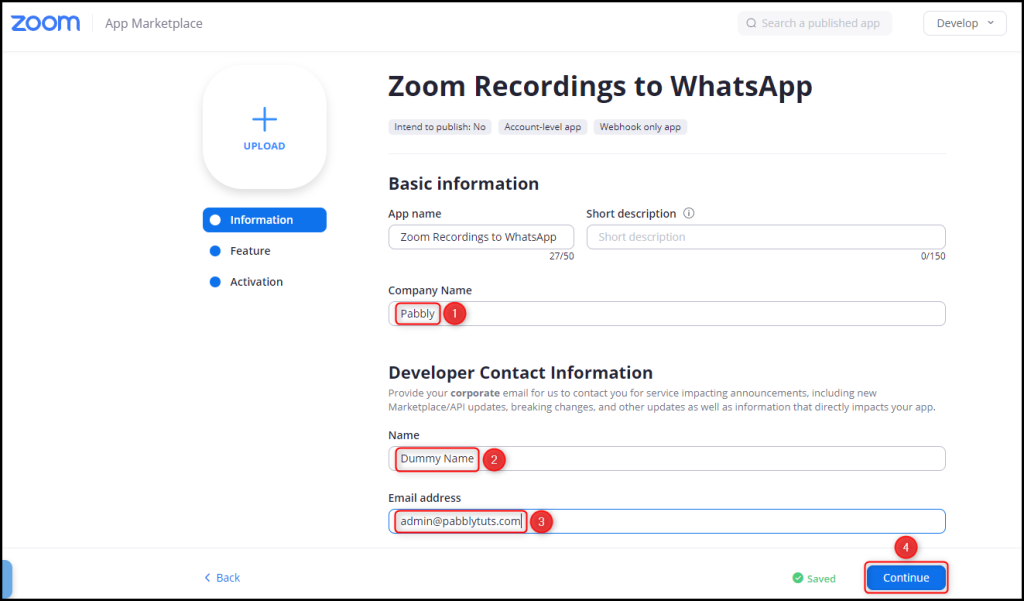
Switch on the Event subscriptions toggle, and click on ‘Add Event Subscription’.
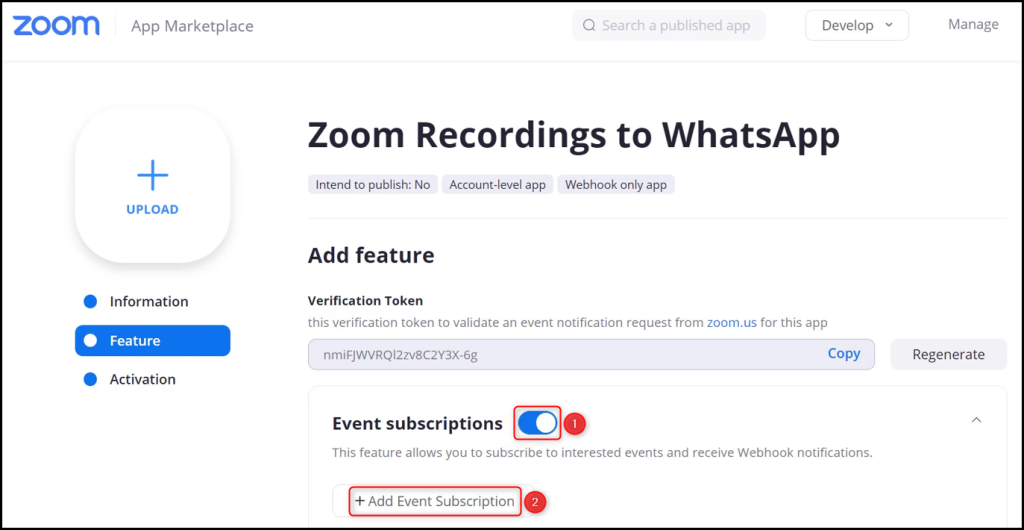
Paste the Webhook URL we copied earlier, and click on ‘Add Events’.
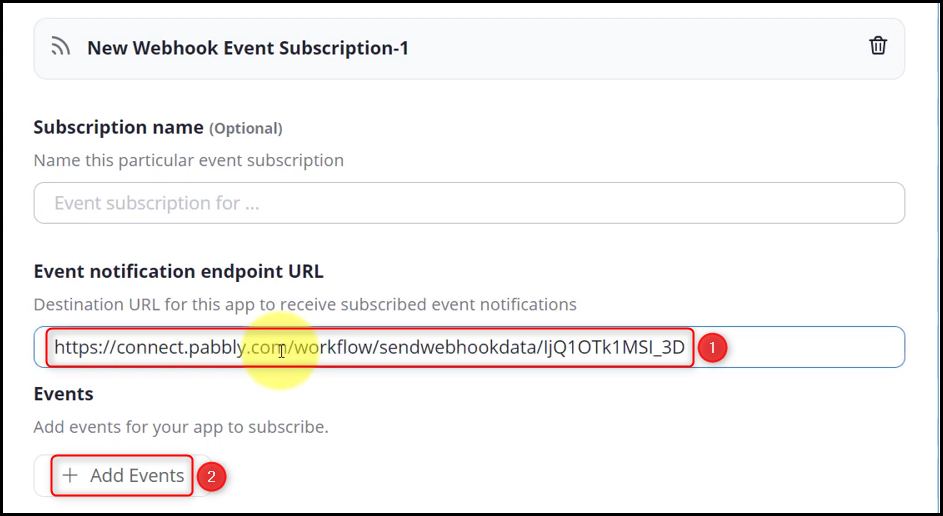
Under Event types, click on ‘Recording’ > ‘All Recordings have completed’ > ‘Done’.
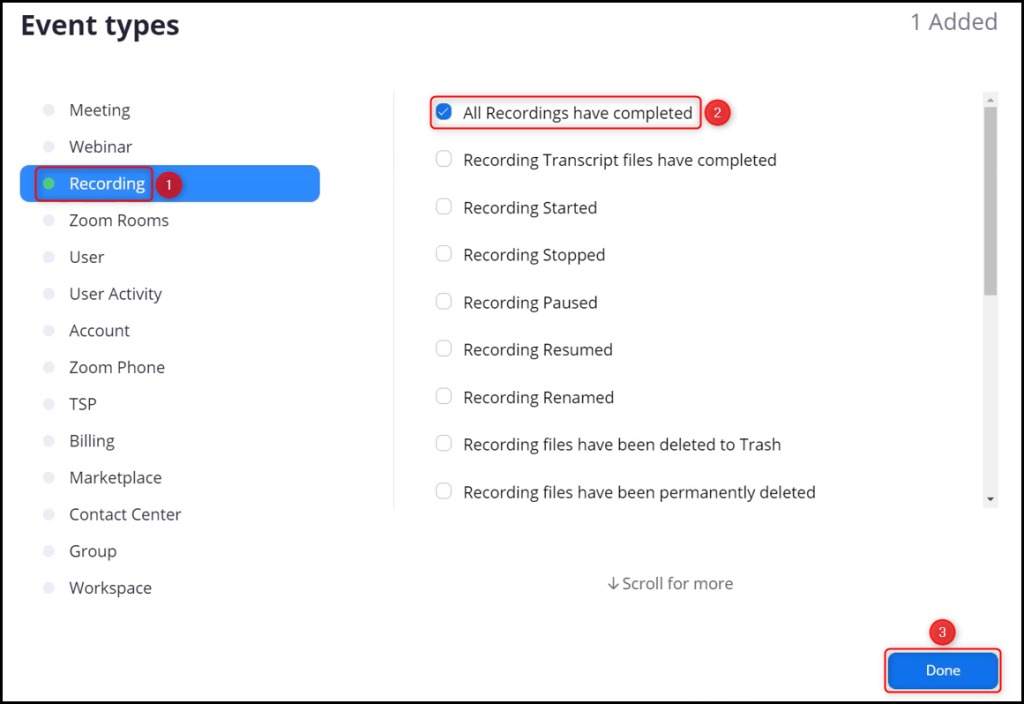
Click on ‘Save’, then ‘Continue’.


D. Test Connection
To test the established connection, we will host and record a meeting, then check for the received response.
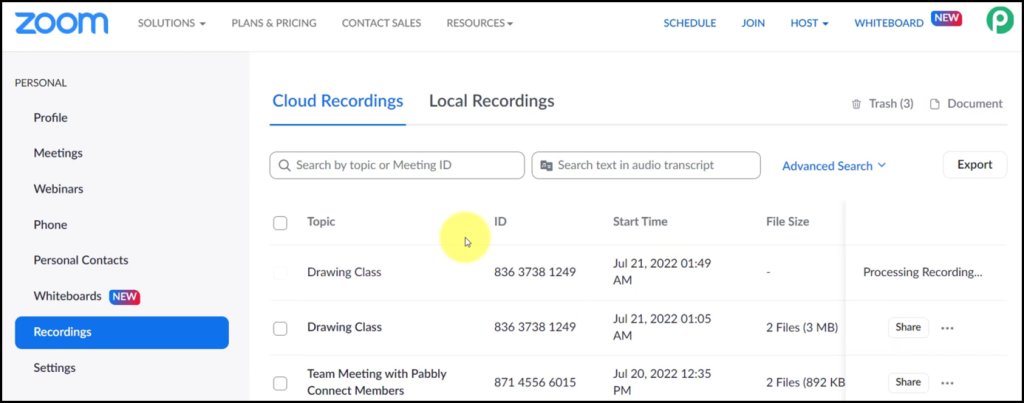
Once the recording is processed, Pabbly Connect will capture the recording link, visible under Received Response, thus confirming our connection.
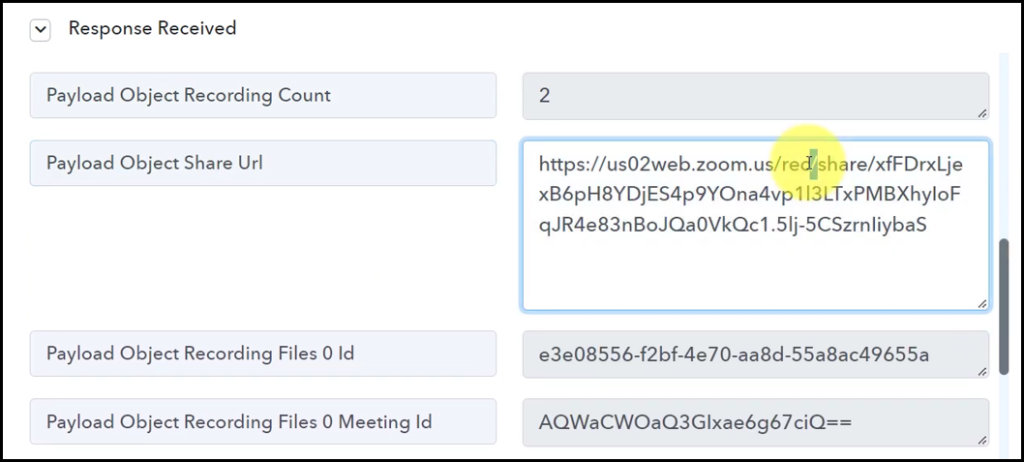
We have established a link between Zoom and Pabbly Connect. Pabbly Connect will now automatically capture the link to your Zoom recordings.
Step 3:- Setup Zoom as the Action App to Fetch Meeting Registrants
Action allows us to choose the application that will get executed by the workflow trigger.
We essentially want to send a meeting recording link to the Zoom meeting registrants. To capture the registrant details – we will set up Zoom as the Action App.
A. Action App
Choose ‘Zoom’ as the Action App, select ‘List Meeting Registrants’ as an Action Event, and click on ‘Connect’.
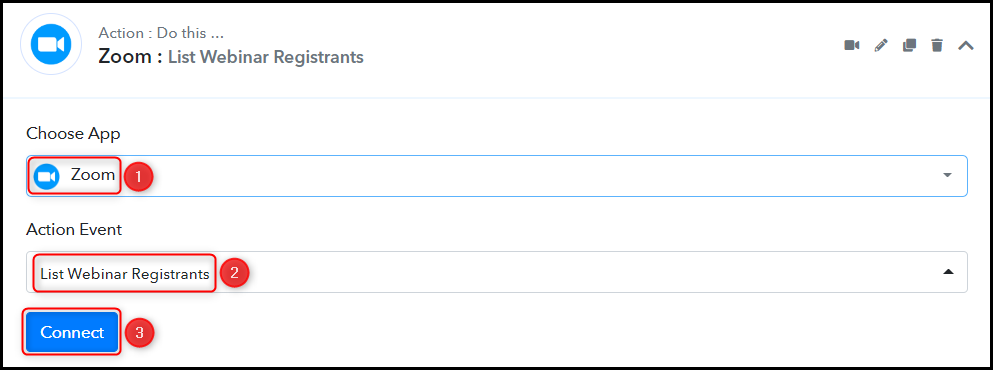
B. Add New Connection
To connect with your Zoom account, select ‘Add New Connection’ and click on ‘Connect With Zoom’. Also, grant the authorization.
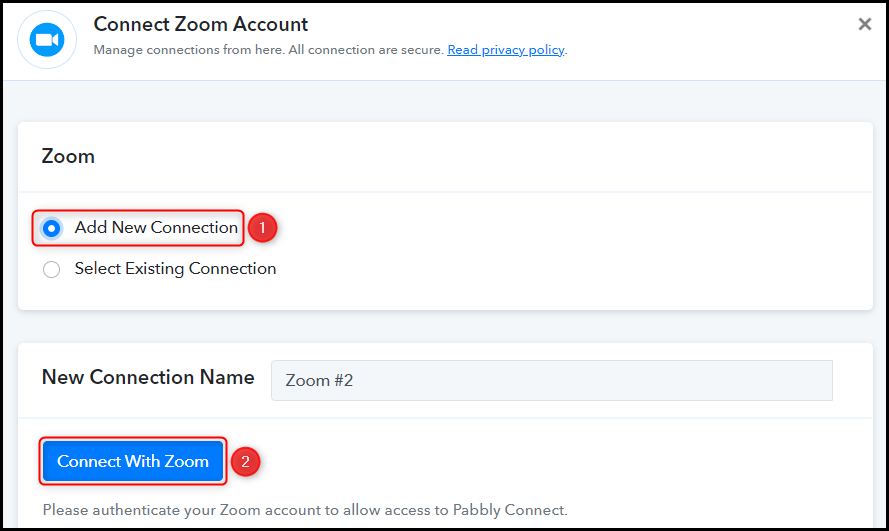
C. Map the Meeting Id
Now that you have connected your Zoom account, all you need is to map the Meeting Id from the step above. Mapping ensures our data remains dynamic and changes as per the received responses.
Map the Meeting Id from the step above.
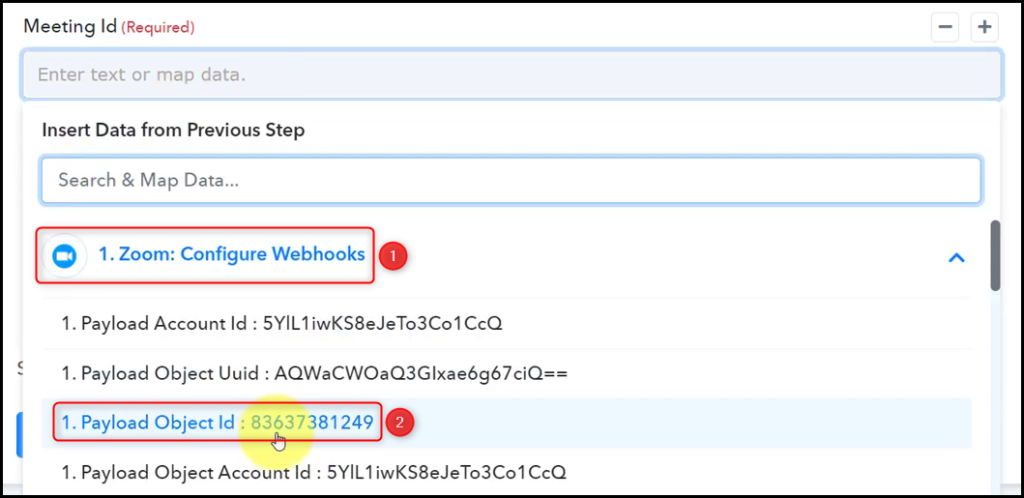

Toggle off the Simple Response, and click on ‘Save & Send Test Request’.

Expand Response Received, and your meeting registrants must be visible.
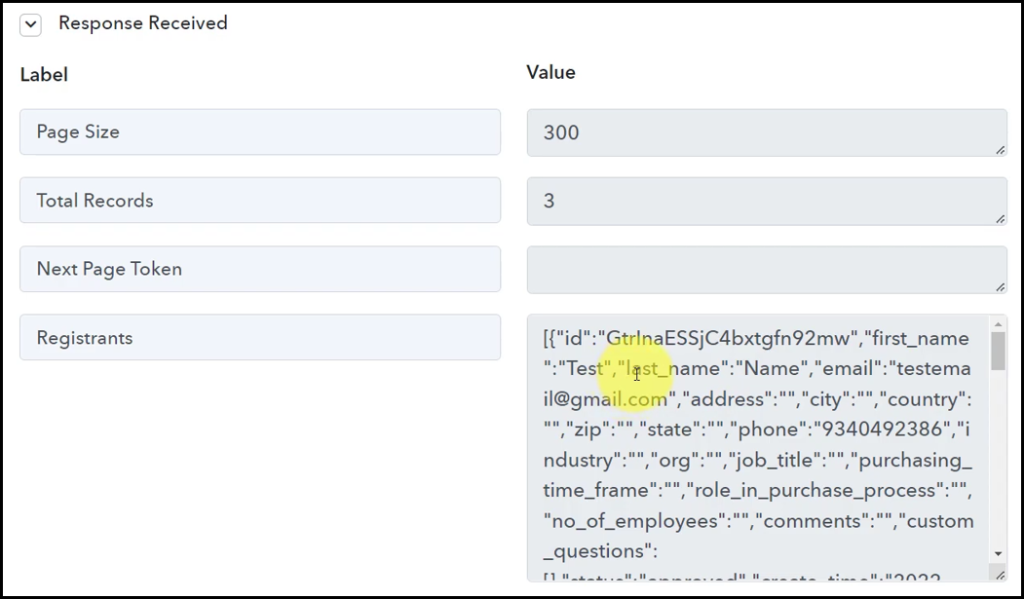
Step 4:- Add an Iterator to the Workflow to Organise Data
The data we captured from Zoom gives us participant details in bulk – we cannot use this data in a meaningful way. To sort this data, we will use Iterator by Pabbly.
Add another Action Step to your workflow by clicking the ‘+’ button.

Choose ‘Iterator by Pabbly’ as the Action App, and click on ‘Save & Send Test Request’.
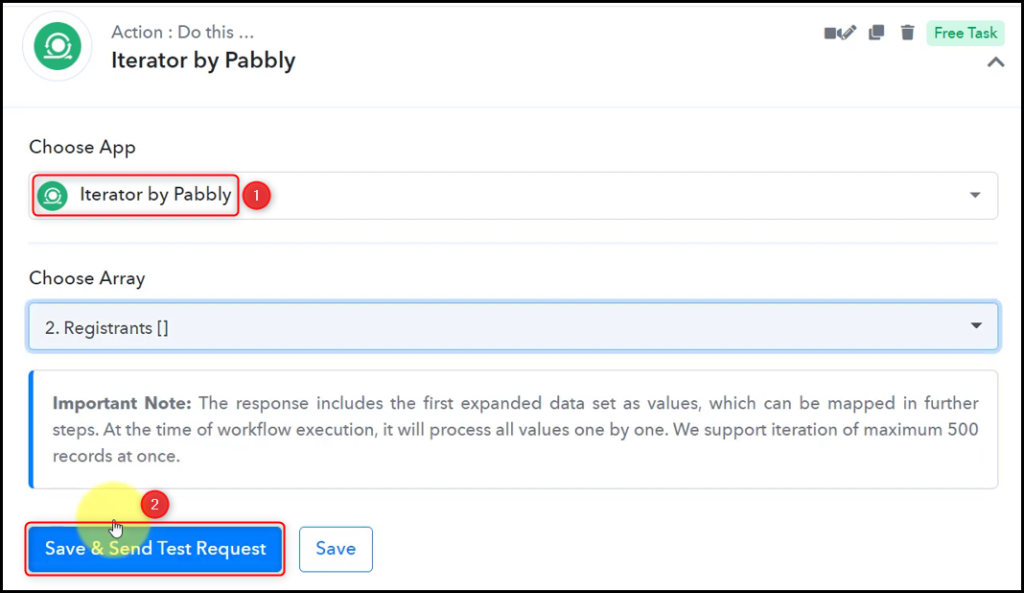
Proper participant details are now visible, and we can use them to send WhatsApp messages.
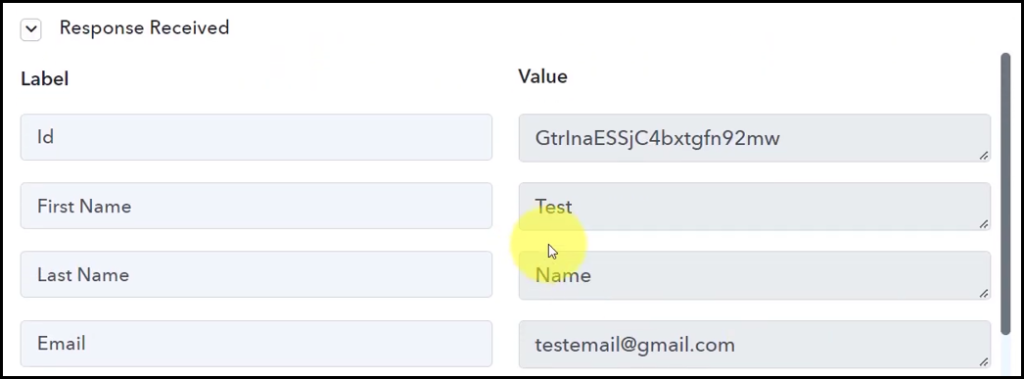
Step 5:- Add a Filter to the Workflow
In Zoom, we can have multiple recordings in our recording list, but we want to send the recording of a particular meeting of our choice. To do so, we will add a Filter to our workflow and filter out all other recordings.
Add another Action Step to your workflow by clicking the ‘+’ button.

Choose ‘Filter by Pabbly’ as the Action App, select ‘Payload Object Id’ as your Label, select ‘Equal to’ as the Filter Type, and enter the exact Meeting Id as Value. At last, click on ‘Save & Send Test Request’.


Doing this will ensure that the next step in our workflow will only be executed for only this particular recording.
Step 6:- Setup WhatsApp Cloud API as the Action App to Send Recordings
We essentially want to send the Zoom recording link to the registrants on WhatsApp. Thus, WhatsApp Cloud API will be our Action App.
Note: Follow steps 1 to 3 of this blog to create a new Whatsapp Business Cloud API account if you don’t already have one.
Add another Action Step to your workflow by clicking the ‘+’ button.

A. Action App
Choose ‘WhatsApp Cloud API’ as your Action App, select ‘Send Template Message’ as an Action Event, and click on ‘Connect’.
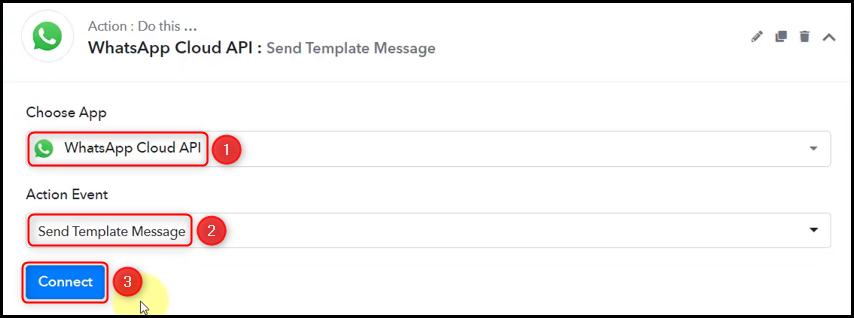
B. Connect WhatsApp Cloud API Account
To connect with your WhatsApp Cloud API account, select ‘Add New Connection’. You will be asked to enter your Permanent Token, Phone Number ID, and WhatsApp Business Account ID.
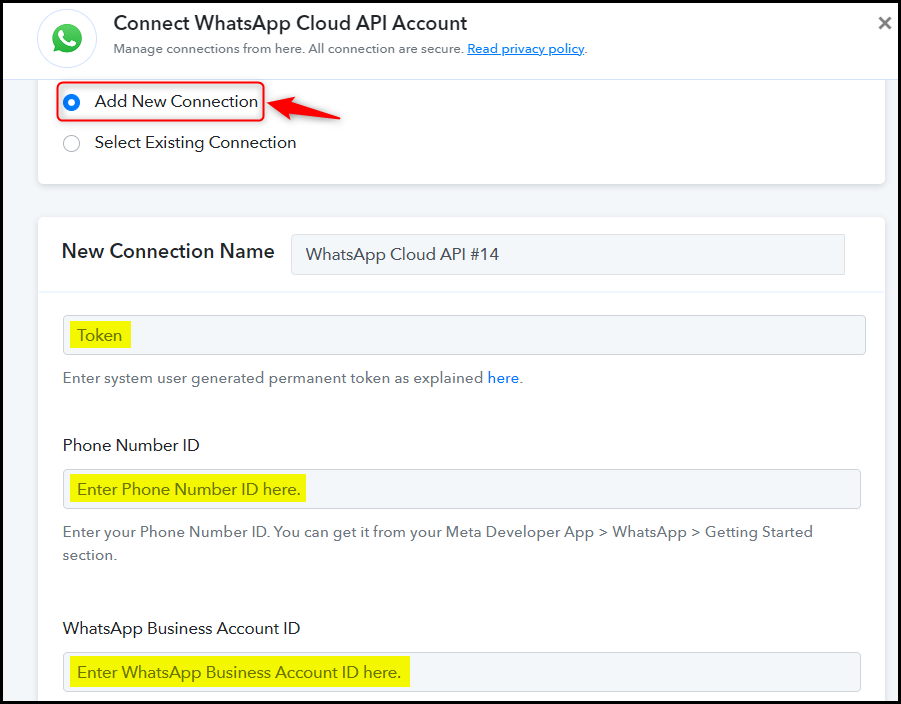
Go to your Facebook Developer dashboard, and copy the Phone Number ID and WhatsApp Business Account ID.
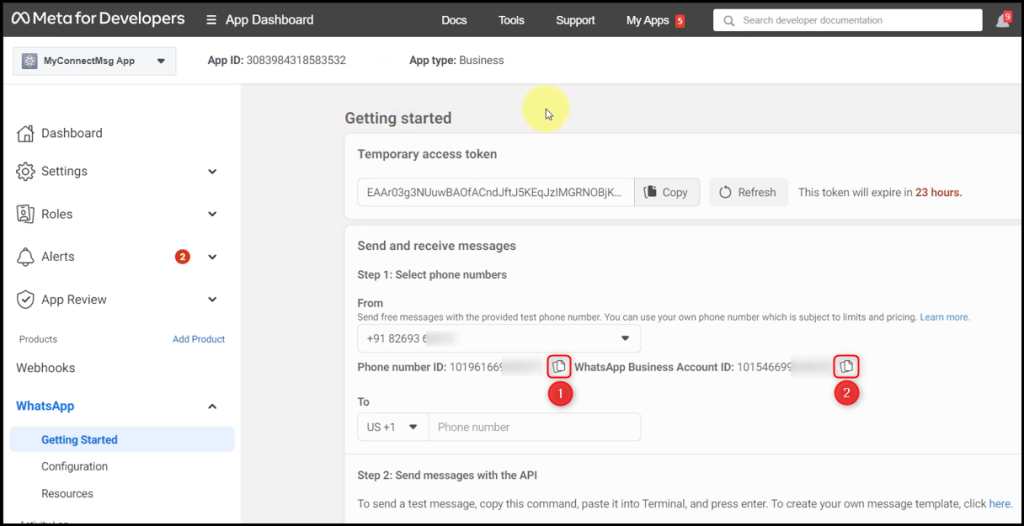
Paste both in their respective fields.
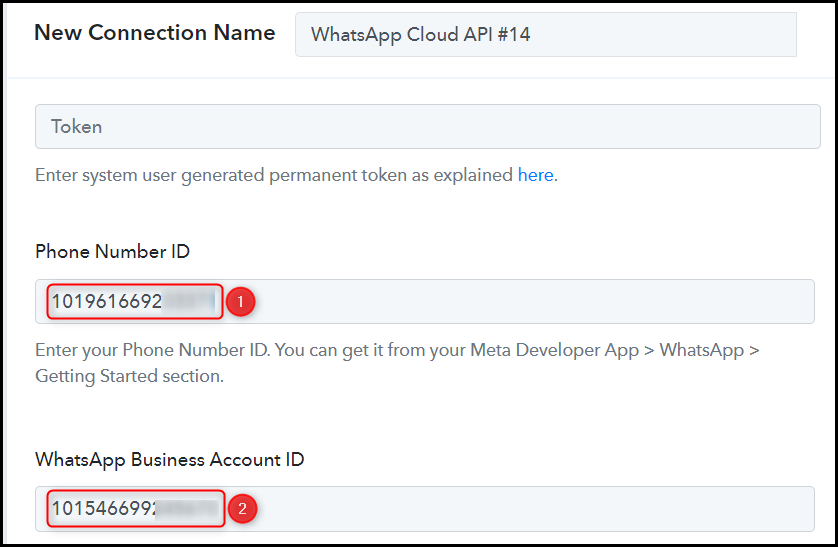
The Token visible on your dashboard is a temporary one that expires every 24 hours. For our workflow, we need a Permanent Token. You can generate a Permanent Access Token by following the steps given in this post.
Paste the Permanent Token, and click on ‘Save’.
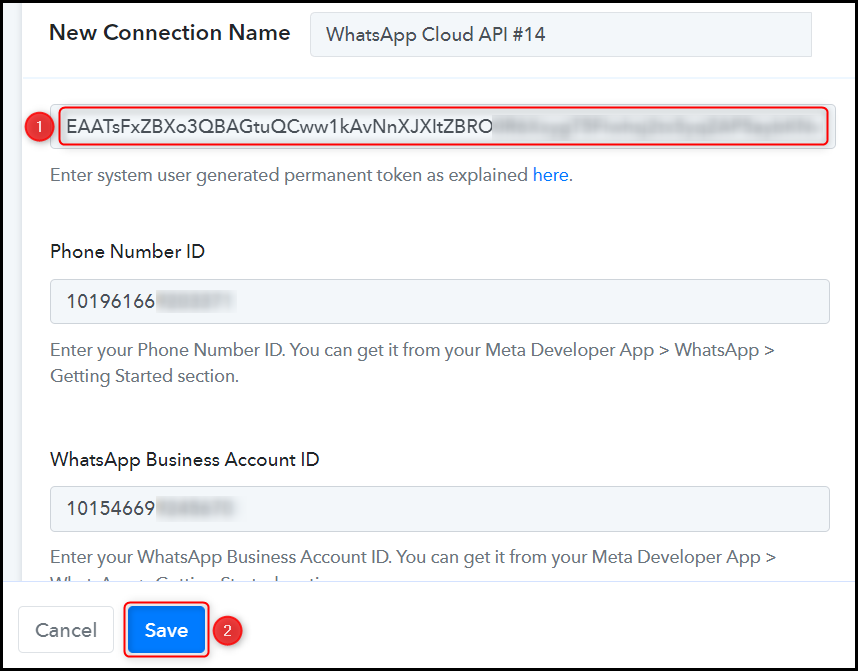
Step 7:- Compose a Message Template
You will be asked to fill up a few fields. You can either select your Template Name directly from the list if you already have one ready or create a new message template by following these steps.

A. Create a Message Template
Switch to your WhatsApp Cloud API dashboard, and click the ‘here’ hyperlink. You will be redirected to a new page.
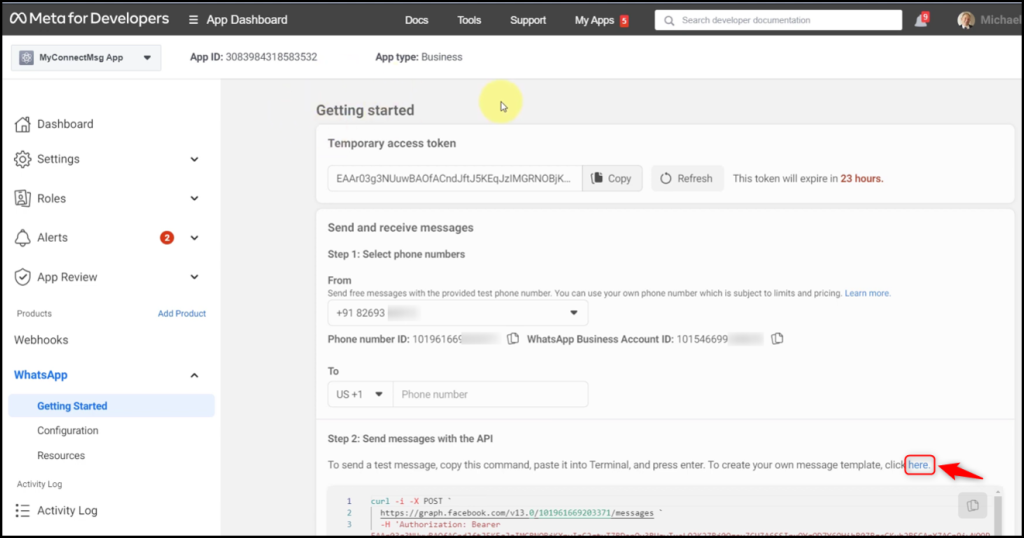
Click on ‘Create Message Template’.

Select a Category, Name the template and pick a Language. Click on ‘Continue’.
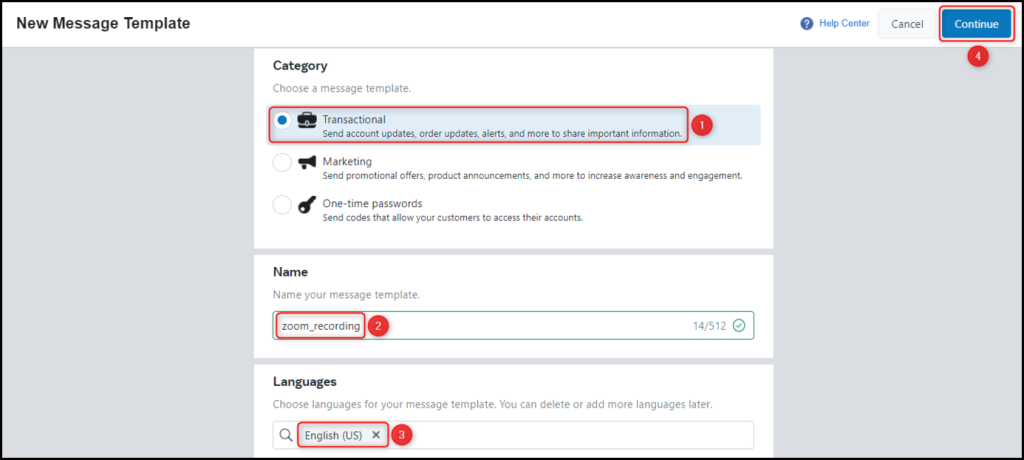
B. Body with Dynamic Data Tags
Type in your message in the Body field. To personalize your message, include Dynamic Data Tags in your template.
Dynamic Data Tags help us to include variables in our template, these variables will be replaced with actual data in your message. The actual data can be a name, an email address, date, time, ID number, etc. To add a dynamic tag to your template, write your variables between double curly braces {{variable}}.
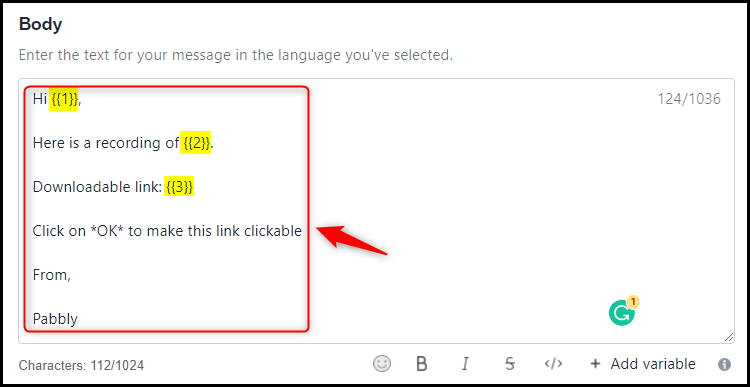
‘Submit’ your message and ‘Confirm’.

As you submit your template, it could be approved right away or go to Facebook for a manual review. This process may take anywhere from a few minutes to a few hours. Reload your page to see if your template is approved and available, as indicated by the green dot.

Step 8:- Map the Necessary Fields
Now that you have connected your WhatsApp Cloud API account, all you need is to map the necessary details from the step above.
Select your Template Name.

Map the Recipient Mobile Number from the step above.


Remember the Dynamic Data Tags we talked about? Those tags will be replaced by the data present in Body Fields.
In Body Field, enter or map the relevant data from above. This could vary as per your choice of variable. Click on ‘Save & Send Test Request’.


As soon as you click on Save & Send Request, a WhatsApp message containing the recording link will be sent to the recipient’s mobile number.
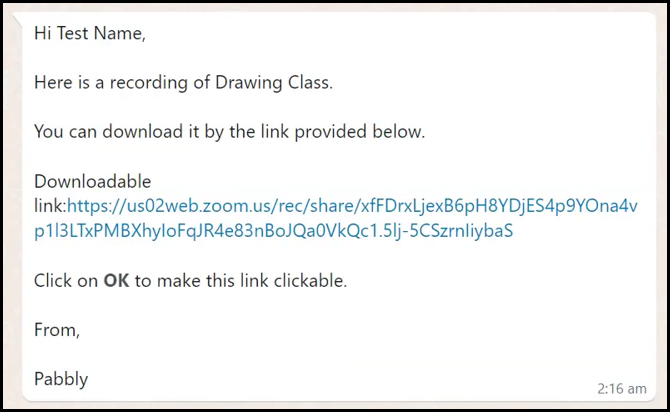
Our automation is complete. We have successfully integrated Zoom with WhatsApp. Once your meeting ends, its recording will automatically be shared with the meeting registrants on their WhatsApp accounts.
You can copy this entire workflow by clicking this link.
Sign Up for a free Pabbly Connect account, and start automating your business
Subscribe to our Youtube Channel for more such automation
For any other queries, visit our forum
